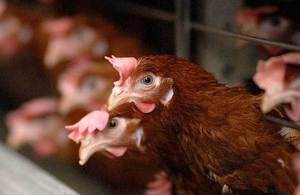# 9664
Stressing that this is supposedly a less worrisome (albeit, not fully identified) subtype of avian flu, DEFRA today has announced the detection of what they suspect is H7N7 at a chicken farm southern County of Hampshire, England.
A low severity case of avian flu has been confirmed in chickens at a farm in Hampshire.
A low severity case of avian flu has been confirmed in chickens at a farm in Hampshire and robust action is being taken to prevent any spread of the disease, which poses very low risk to human health.
Tests have confirmed the outbreak as a low severity H7 strain of the disease, a much less severe form than the H5N8 strain found at a Yorkshire duck farm in November. There are no links between the two cases.
A 1km poultry movement restriction zone has been imposed and the birds at the commercial chicken breeding farm are to be culled as part of our tried and tested procedures for responding swiftly and thoroughly when an outbreak occurs.
The advice from Public Health England is that the risk to public health is very low, and the Food Standards Agency has said there is no food safety risk for consumers.
Chief Vet Nigel Gibbens said:
We have taken immediate action to contain this outbreak as part of our robust procedures for dealing swiftly with avian flu. This is a low severity form of the virus and we are taking action to ensure that the disease does not spread or develop into a more severe form. We are investigating the possible sources of the outbreak.
I would urge poultry keepers in the surrounding area to be vigilant for any signs of disease and to ensure they are maintaining good biosecurity on their premises.
Nick Phin, Director for Centre for Infectious Disease Surveillance and Control said:
Based on what we know about this strain of avian influenza and the actions that have been taken, the risk to human health in this case is considered very low. Public Health England continues to work closely with Defra throughout this investigation.
A spokesperson for the Food Standards Agency said:
On the basis of current scientific evidence, Food Standards Agency advice is that avian (bird) flu does not pose a food safety risk for UK consumers.
Laboratory investigations on the outbreak indicate that it is the N7 sub-type of H7 but this will need to be confirmed in further testing.
Although characterizing this as a `low severity’ virus, it isn’t at all clear whether this is a LPAI or HPAI virus. Hopefully we’ll get more information once additional testing is completed, and the OIE report is filed.
Although the UK had dealt with other H7 strains (H7N2, H7N3) in the past, it wasn’t until 2008 that England reported an H7N7 outbreak to the OIE (see UK: Outbreak Identified As H7N7).
Until H7N9 turned up (amazingly, less than 2 years ago), H7 avian viruses didn’t get a lot of respect as a human health threat. Human infections were uncommon, and when they were detected, they tended to be mild.
Often little more than sniffles and conjunctivitis.
The `exception’ occurred in 2003, in the Netherlands, where an outbreak of H7N7 infected at least 89 people, killing one. Details on that cluster were reported in the December 2005 issue of the Eurosurveillance Journal.
Human-to-human transmission of avian influenza A/H7N7, The Netherlands, 2003
M Du Ry van Beest Holle, A Meijer, M Koopmans3 CM de Jager, EEHM van de Kamp, B Wilbrink, MAE. Conyn-van Spaendonck, A Bosman
An outbreak of highly pathogenic avian influenza A virus subtype H7N7 began in poultry farms in the Netherlands in 2003. Virus infection was detected by RT-PCR in 86 poultry workers and three household contacts of PCR-positive poultry workers, mainly associated with conjunctivitis.
Roughly 30 million birds residing on more than 1,000 farms were culled to control the outbreak. One person - a veterinarian who visited an infected farm – died a week later of respiratory failure.
More recently (and more typically), in 2013, we saw three poultry workers in Italy infected with H7N7 (see ECDC Update & Assessment: Human Infection By Avian H7N7 In Italy). All three experienced mild symptoms (primarily conjunctivitis), although one did report muscle aches and chills.
While normally credited with producing mild symptoms in humans – H7N7 - like all influenza viruses, is constantly mutating and evolving.
But for now, H7N7 is believed to pose only a minimal risk to human health. For more on H7 viruses, you may wish to revisit Brief History Of H7 Avian Flu Infections.

